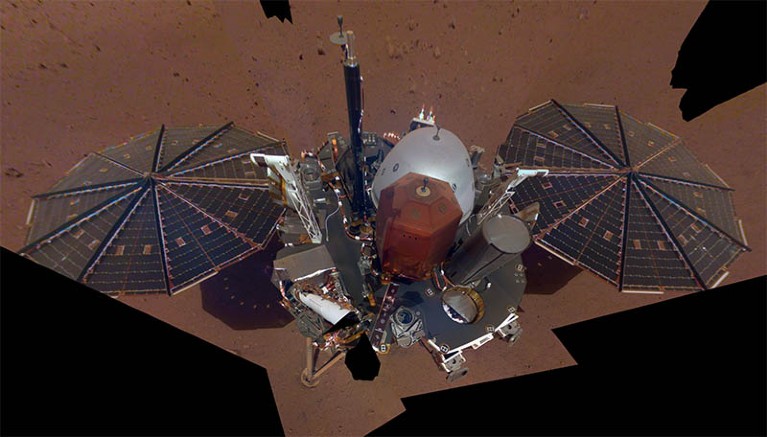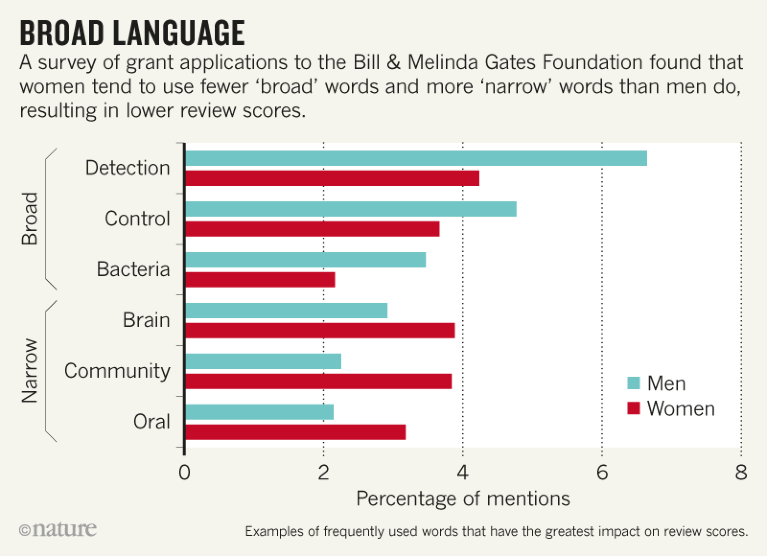SPACE
First ‘marsquake’ confirmed NASA’s InSight lander has detected the first known ‘marsquake’ — a faint trembling of the red planet’s surface on 6 April. The quake, announced on 23 April, is the first to be detected on a planetary body other than Earth or the Moon. The relatively weak shaking was similar to that of moonquakes measured by Apollo astronauts in the late 1960s and early 1970s. It’s not yet clear whether the marsquake originated inside the planet or was caused by a meteorite crashing into Mars, sending ripples through its interior. InSight heard the marsquake using a French-built seismometer that contains three extremely sensitive sensors nestled inside a dome to protect them from the wind. Mission scientists had previously observed vibrations caused by the Martian wind blowing overhead. They have also detected three potential marsquakes fainter than the 6 April event.

NASA’s InSight lander has detected the first known ‘marsquake’.Credit: NASA/JPL-Caltech
Asteroid mission China is planning a robotic mission that would return samples from an asteroid and visit a comet, and it has invited international researchers to take part. The ten-year mission, which has yet to be formally approved, could launch as soon as 2024, says Yang Ruihong, international cooperation manager at the China National Space Administration (CNSA). Japan and the United States both have spacecraft orbiting asteroids and, in 2010, Japan’s Hayabusa mission became the first to bring back samples of an asteroid to Earth. China’s mission would visit the asteroid 2016 HO3 and the comet 133P/Elst–Pizarro, and would return material from the asteroid by dropping a capsule back to Earth. It aims to study the evolution of small bodies in the Solar System. The CNSA is encouraging foreign research institutions to propose scientific payloads that could fly on the mission, according to details published by the agency on 19 April.
EVENTS
JASON lifeline The elite advisory panel known as JASON, which has provided technical advice to the US government for decades, was given a reprieve on 25 April — days before it was set to shut down. The National Nuclear Security Administration (NNSA), a branch of the energy department that manages nuclear weapons, has offered to fund the group’s work until January 2020. JASON’s future came into question last month when the Department of Defense abruptly decided not to renew its contract with the MITRE Corporation, a non-profit consultancy in McLean, Virginia, that manages the contract on JASON’s behalf. The decision effectively cancelled the panel’s projects for other government agencies, because JASON’s government work was funnelled through its defence-department contract. The group, whose members are known as Jasons, was founded by physicists in 1960 and has tackled a wide range of subjects, including national defence, health care and artificial intelligence.
POLICY
Gene-therapy guide The US National Institutes of Health (NIH) has streamlined its oversight of emerging gene therapies, it said on 25 April. The agency has dropped a rule mandating that NIH-funded researchers register human trials of gene therapies with the Recombinant DNA Advisory Committee (RAC); clinical trials of such treatments are still under the oversight of the Food and Drug Administration. The NIH will shift the RAC from evaluating the use of modified DNA in the human body to examining the safety and ethics of a broader range of new biotechnologies. The 45-year-old committee will now be known as the Novel and Exceptional Technology and Research Advisory Committee. The NIH said in a statement that gene therapy had advanced to the point at which it no longer required special oversight.
RESEARCH
Ocean viruses The world’s oceans harbour nearly 200,000 virus species — two orders of magnitude more than scientists had previously recorded, according to a survey of marine microbes. The results, published on 25 April (A. C. Gregory et al. Cell https://doi.org/gfzvv4; 2019), provide scientists with a foundation for understanding how viruses affect marine ecosystems — including the effect they have on the way organisms interact and the ocean’s response to climate change. Researchers collected seawater samples from nearly 80 sites around the world between 2009 and 2013, from surface waters to depths of 4,000 metres. The effort was part of two larger projects that study carbon dioxide and climate change in Earth’s oceans. A previous analysis of marine viruses by these missions had identified more than 15,000 species. Scientists analysed the viral DNA in the latest samples and found nearly 200,000 species in 5 ocean zones around the globe. The most diverse communities were in the Arctic Ocean and in temperate and tropical surface waters.
AWARDS
Quantum prize A private Chinese foundation has announced the first 12 winners of the Micius Quantum Prize, a new prize awarded to quantum scientists from across the world. On 26 April, the Micius Quantum Foundation in Hefei announced winners for the 2018 and 2019 prizes, which recognize quantum computation and quantum communication, respectively. Six scientists won for each year, all of whom will receive one million yuan (about US$150,000). Although the prize recognizes international recipients, it celebrates a field that China increasingly values and contributes to. Recipients include Peter Shor, a mathematician at the Massachusetts Institute of Technology in Cambridge, and David Deutsch, a physicist at the University of Oxford, UK — both of whom wrote pioneering quantum algorithms. Pan Jian-Wei, a physicist at the University of Science and Technology of China in Hefei, who was the main architect of the world’s first quantum-communications space satellite (pictured), is the only award recipient from China.

The Chinese quantum-communications satellite QUESS was developed by Micius prizewinner Pan Jian-Wei.Credit: Xinhua/Alamy
PUBLISHING
Open-access deal The Dutch publishing giant Elsevier has struck a deal with Norwegian universities that will allow academics to publish most of their work under open-access terms. The two-year pilot scheme marks the largest such agreement — often called a ‘read and publish’ deal — that Elsevier has made with a national research consortium. Library consortia worldwide have been pushing for such packages, to cut the costs of reading and publishing articles and to make more of the scientific literature free to read, but Elsevier has largely resisted the trend. The deal will allow scientists at 46 Norwegian institutes to access 2,800 Elsevier journals; and 1,850 articles authored by those academics — about 90% of their Elsevier-published research — will be immediately free to read on publication in Elsevier titles. The deal’s estimated cost is about €10 million (US$11 million).
RESEARCH INTEGRITY
Trial troubles Many of Europe’s major research universities are failing to make the results of clinical trials public. A report published on 30 April found that the results of only 162 of 940 clinical trials (17%) that were due to be published by 1 April had been posted on the European Union’s trials register within 12 months of completion, as is required by EU rules. The 30 universities surveyed are those that sponsor the most clinical trials in the EU. Fourteen had failed to publish results summaries for even one of the trials due. The report’s author, Till Bruckner, of the UK campaign group TranspariMED, says that the true picture is likely to be worse. This is because many old trials listed on the register as ‘ongoing’ could be complete, but the trials’ status might not have been updated on the register. UK universities were among the best at posting results on time.
TREND WATCH
Men and women use different types of words on grant applications, and that can affect their chances of securing funding, according to an analysis. The study looked at almost 7,000 proposals submitted to the Grand Challenges Exploration programme of the Bill & Melinda Gates Foundation between 2008 and 2017 (see go.nature.com/2df4ejd). The fund gives grants of US$100,000 to $1 million to address specific challenges in global health. Women received significantly lower review scores than men, even though reviewers were blind to their gender. This effect couldn’t be explained by applicants’ experience or publication history, but instead was related to communication style. Men tended to use ‘broad’ words — ones that appeared at the same rate in proposals regardless of the topic — and these were associated with higher review scores. But women favoured topic-specific terms, which were related to lower scores. Grant reviewers could be trained to limit their sensitivity to communication styles, the authors suggest. The Gates Foundation says that it is committed to ensuring gender equality and is reviewing the results of the study.

Source: J. Kolev



